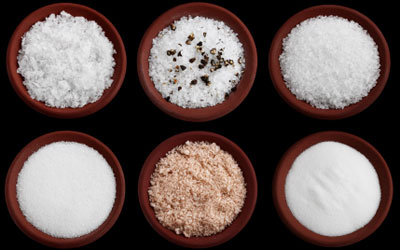Long ago in what is now Central Utah, Native Americans found a mineral-rich salt deposit from an ancient sea when they saw deer eating the soil. in 1959, Milo and Lamar Bosshardt were struggling to keep their family farm afloat when they discovered that this salt deposit extended beneath their land. They began selling the salt to local farmers for their animals and heard reports the farmers were using the salt to season their own food. People insisted this “real” salt be made available for everyday use, and the Real Salt brand was born.
Today, Real Salt is brought to you in its natural state – without additives, chemicals, or heat processing of any kind. Real Salt’s unique pinkish appearance and flecks of color come from more than 60 naturally occurring trace minerals. The result is a delicate “sweet salt” flavor that you many not have experienced before.
Have you ever heard the phrase, “They’re worth their salt?” It means that a person is worth their pay. You see, there was a time that salt was so valued that people were paid with it. The word salt itself actually comes from the Latin word salarium meaning salary. Salt bars were even used as a form of currency for more than 1,000 years in Ethiopia, and in Greece, salt was exchanged for slaves.
Before refrigeration, salt was necessary to preserve foods, and in the American Civil war, part of the North’s strategy was to disrupt the South’s supply of salt preventing their preservation of food which limited their ability to feed their army.
Salt mines were part of the expansion west after the Civil War as well. Detroit and Cincinatti are actually built on top of salt mines.
Saline solution is used in IV’s as an invaluable treatment in emergency rooms.
So how is it that salt is no longer “worth it’s salt?”
Well that began about 150 years ago when salt began to be “refined”. The refining process strips salt of minerals (they’re referred to as “impurities”) using sulfuric acid. The salt is then heated to 1200* F. What’s left is 100% sodium chloride. To enhance the flavor and prevent caking, aluminum, anticaking agents, and dextrose are added, which stains the salt purple. To get the “pretty” white color, the salt is then bleached.
By contrast, unrefined salt is about 82% sodium chloride and about 80 different minerals and elements – all the natural elements necessary for life – including magnesium and calcium; and trace elements, like iodine, potassium, and selenium.
Refined salt upsets fluid balance in the body, dehydrates the cells, hampers the immune system, initiates and accelerates chronic illness, and promotes acidity in the body. Unrefined salt is easily used by the body. The minerals are essential for a healthy immune system.
Kristin Wartman, in her article “Changes in Season: Why Salt Doesn’t Deserve It’s Bad Rap“, explains that, “Sodium is one of the two major electrolytes our bodies need to function properly, and like any other element, nutrient, vitamin, or mineral we put into our bodies, it does not exist or function in isolation. Sodium is important for maintaining blood volume, it works in concert with potassium, which is needed for vasodilatation or constriction, and it also interacts with calcium, which is needed for vascular smooth muscle tone. Sodium exists in all of the fluids in our body and is essential to water balance regulation, nerve stimulation, and proper function of the adrenal glands. It is also crucial to maintaining mental acuity — sodium is required to activate glial cells in the brain — these cells make up 90 percent of the brain and are what makes us think faster and make connections. This is part of the reason sodium deficiency (sunstroke, heat exhaustion) leads to confusion and lethargy as the human brain is extremely sensitive to changing sodium levels in the body.”
David Brownstein, MD, in his book “Salt Your Way to Health“, discusses the impact of low-salt diets on increased risk for heart attacks, insulin resistance, polycystic ovaries, obesity, higher LDL levels as well as total cholesterol levels, and in the body increasing certain hormones to help the kidneys retain more sodium which can overstress the sympathetic nervous system.
So in answer to the question, “Is salt worth it’s salt?” I guess that depends on the salt that you use.
“Salt Your Way to Health” by David Brownstein, M.D., provides the following uses for salt:
Allergic Rhinitis (runny nose): Mix 1/4 tsp of salt with 1/4 tsp baking soda in 8 oz of pure water and use as a nasal spray. It will help lubricate and stop drainage of the nasal passages; it also acts as an antibacterial agent. In addition, salt has antihistamine properties.
Asthma: At the onset of wheezing, place one large pinch of salt on your tongue and drink 8 oz of pure water (room temperature). Repeat in 15-30 minutes. Dr. Brownstein states that this regimen has helped him numerous times with his asthma.
Detoxification: Adding 2 cups of salt and 2 cups of baking soda to the bath water can help stimulate the lymph system. This can aid in any detoxification plan.
Exercise: At the start of exercise, take one large pinch of salt with a glass of water. If the exercise results in a large amount of sweating, repeat at the end of teh exercise session.l Salt will prevent muscle cramps and aid in muscle recovery after exercise.
Gastritis: Taking a large pinch of salt with meals helps to prevent reflux problems. Salt is an alkalinizing agent and helps to buffer excess acidity in the stomach.












Great info on salt – thanks for all your research. This explains a lot for me. I’ve recetnly undergone a lot of unconventional testing. One test showed that I’m dehydrated and my sodium levels are extremely low. The funny this is that I drink a least a gallon of water a day and consume quite a bit of salt.